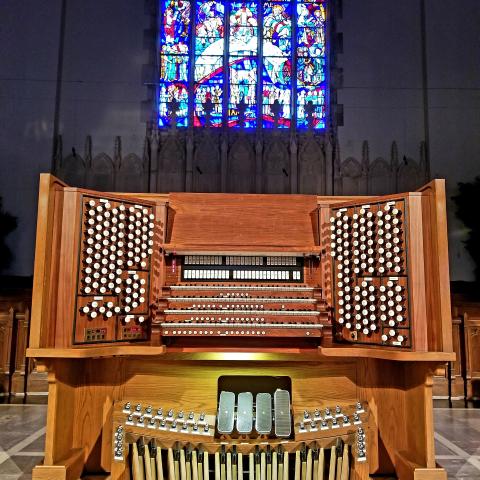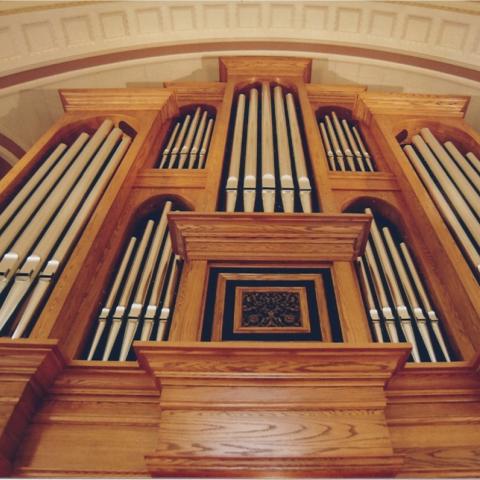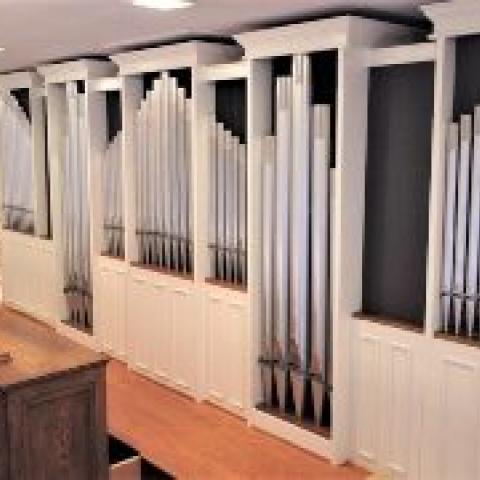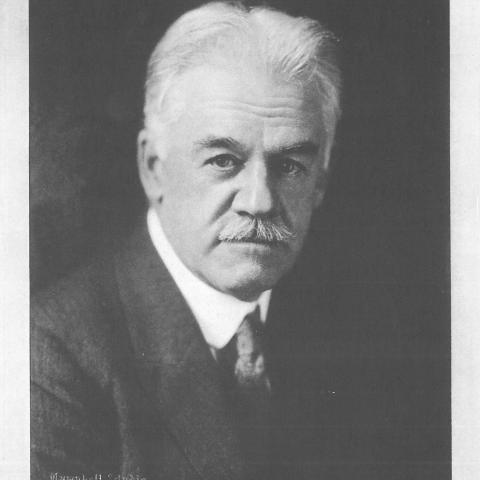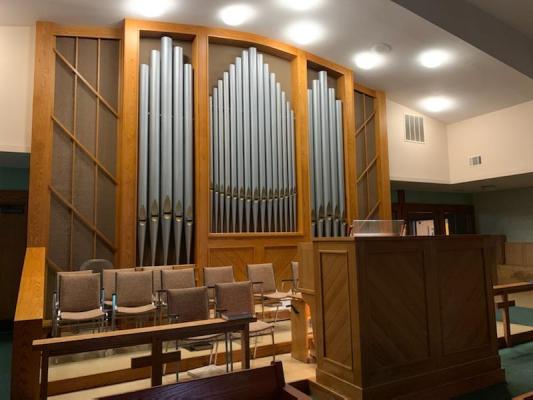
Scott Smith Pipe Organs, Lansing, Michigan
Grace Lutheran Church, Auburn, Michigan
Auburn is a modest-sized city of just over 2,000 in the Great Lakes Bay Region of Michigan, nearly equidistant from Midland to the west, Bay City to the east, and slightly farther from Saginaw to the south. As a result, the churches in this region draw members from a rather diverse culture, comprising everything from chemical engineering to manufacturing to agriculture.
Around 1980, a local builder moved a small, two-manual Wicks organ into Grace Lutheran from a church in Maple Heights, Ohio, replacing an electronic substitute. In 1986, the church expanded in size, and the organ was moved to the rear of the sanctuary and enlarged to fifteen ranks.
The instrument came to us as a new service account a few years ago. Almost immediately, Nathan Beethe, the church’s music director, initiated what was to become an ongoing discussion about the condition of the organ, its built-in constraints, and some changes he would like to see. Chronic dead notes and ciphers were only the beginning. The organ’s overall character was harsh and loud, posing constant challenges in registration choices, particularly for offertories and choir accompaniment. Perhaps the most annoying issue for organists was the failing console and the limitations posed by its 56-note manual compass controlling 61-note chests.
Soon, the church underwent a facility-wide upgrade, and the organ became an integral part of that overall improvement. The first thing we asked the church to do was to beef up the back wall of the chamber, as the 16′ Subbass was sorely lacking in projected power into the sanctuary. Its bass sound waves were being transmitted through a single layer of gypsum board to the chapel behind. The vibration of the 16′ Subbass vigorously shook the chapel’s shared back wall on the other side of the studs. An additional layer of gypsum board had a dramatic effect of focusing the bass tones, and the Subbass could be heard and felt for the first time in the surprisingly good acoustic of the sanctuary.
Joe Granger of our team worked with Organ Supply Industries on the design of a new console, which offers two 61-note manuals and an exterior cabinet of red oak in a diagonal shiplap design that matches the cabinetry of the organ casework. The elegant new console features drawknobs instead of the tongue tabs on the old unit. Joe collaborated with Kantor Beethe to develop the new specification.
In our opinion, a fifteen-rank organ did not require three 2′ stops, so the Swell 2′ Principal was replaced by a 100-year-old Austin 4′ Harmonic Flute. Its positioning near the Swell opening helps to enhance the delicate spray of harmonics from this beautiful stop that sounds surprisingly at home in the instrument.
The Swell 16′ Trumpet was judged to be too harsh and too thin to adequately cap the rest of the organ in big ensembles and did not work well as a solo stop. Limited by space and therefore unable to install a larger-scaled reed, we handed the work of transforming the stop over to Oyster Pipeworks of Louisville, Ohio. They successfully merged portions of the existing rank with another to create one whose overall character now possesses tones that are darker, warmer, and more pleasing in both ensemble and solo work.
As it stood, we felt that the Great III Mixture (11⁄3′) spoke an octave too high. Through the magic of computer programming, the rank was repitched an octave lower, but still remains available at the original pitch for those occasions when the extra “spice” is desired without the aid of an octave coupler.
The Great 8′ Rohr Schalmei was of limited usage and was replaced with a vintage 8′ Clarinet, believed to have been made by Hook & Hastings.
To make this modest-sized organ as versatile as possible, we made extensive use of the Swell 8′ Viole, which is now also available as a three-rank derived Swell III Mixture (2′, breaking), Swell 11⁄3′ Larigot, and Great Grave Mixture II (2′ and 22⁄3′, non-breaking). This medium-scale, rather generic string was nearly perfect as it stood to provide the basis for these faux stops, in addition to its normal duty as the Swell Viole.
In the 1986 expansion, the low twelve Pedal 16′ Subbass pipes were extended upward for the next twenty notes with chunky zinc/spotted metal pipes, which were never very effective, nor did they match well. These were replaced with wood pipes, merging two vintage Estey sets, and rescaled to match the Wicks Subbass. The end result now brings warmth and power to the entire compass of the organ’s bass. Combining these two nearly identical sets also allowed us to slow down the halving ratio in the treble portion of its compass.
Today, the instrument’s ensemble is warmer, darker and fuller than before, without sacrificing a great deal of its brilliance. The reworked swell mechanism now provides greater and more subtle dynamic control, and the revised stoplist offers a more diverse palette of options for the organist. A Peterson ICS-4000 organ control system was chosen for the relay and multi-level combination action.
We acknowledge Richard Swanson of R. T. Swanson, Inc., who initially consulted on and assisted with installation of the first two incarnations of this instrument, and freely shared his file and drawings with us.
—Joe Granger, Scott Smith; Scott Smith Pipe Organs, Lansing, Michigan
Photos by Joe Granger
GREAT (Manual I)
16′ Bourdon Doux (Sw 16′ Bourdon)
8′ Diapason 61 pipes
8′ Bourdon 73 pipes
8′ Viole (Sw 8′ Viole)
8′ Viole Celeste (TC) (Sw 8′ Viole Cel)
4′ Octave 61 pipes
4′ Flute (ext 8′ Bourdon)
2′ Principal Conique 61 pipes
III Mixture (22⁄3′) 183 pipes
III Cymbale (11⁄3′) (fr III Mixture)
II Grave Mixture (fr Sw 8′ Viole)
16′ Contre Trompette (Sw 16′ C Trom)
8′ Trompette (Sw 16′ Contre Tromp)
8′ Clarinet 61 pipes
Chimes 21 tubes
Great 16
Great Unison Off
Great 4
Zimbelstern
SWELL (Manual II, enclosed)
16′ Bourdon 97 pipes
8′ Bourdon (ext 16′ Bourdon)
8′ Flute Conique (1–12 fr 16′ Bour,, 13–61 fr 4′ Flute Conique)
8′ Viole 85 pipes
8′ Viole Celeste (TC) 49 pipes
4′ Flute Harmonique 61 pipes
4′ Flute Conique 61 pipes
4′ Viole (ext 8′ Viole)
2-2⁄3′ Nasard (ext 16′ Bourdon)
2′ Flute (ext 16′ Bourdon)
1-3⁄5′ Tierce (fr 16′ Bourdon)
1-1⁄3′ Larigot (fr 8′ Viole)
III Plein Jeu (2′)(fr 8′ Viole)
16′ Contre Trompette 85 pipes
8′ Trompette (ext 16′ Contre Tromp)
4′ Clarion (ext 16′ Contre Tromp)
Swell 16
Swell Unison Off
Swell 4
Tremolo
PEDAL
32′ Resultant (16′ Soubasse, 10-2⁄3′ Bdn)
16′ Soubasse 44 pipes
16′ Bourdon (Sw 16′ Bourdon)
8′ Flute (ext 16′ Soubasse)
8′ Bourdon (Sw 16′ Bourdon)
8′ Diapason (Gt 8′ Diapason)
4′ Flute (Sw 16′ Bourdon)
4′ Octave (Gt 4′ Octave)
16′ Contre Trompette (Sw 16′ C Trom)
8′ Trompette (Sw 16′ Contre Tromp)
COUPLERS
Great to Pedal 8
Great to Pedal 4
Swell to Pedal 8
Swell to Pedal 4
Swell to Great 16
Swell to Great 8
Swell to Great 4
ACCESSORIES
10 General pistons (thumb and toe)
5 Great pistons (thumb)
5 Swell pistons (thumb)
3 Pedal pistons (toe)
General Cancel (thumb)
Setter (thumb)
Great to Pedal reversible (thumb and toe)
Swell to Pedal reversible (thumb and toe)
Swell to Great reversible (thumb and toe)
Sforzando (thumb and toe)
Combination level, up or down (thumb)
Transposer (up/down, thumb)

